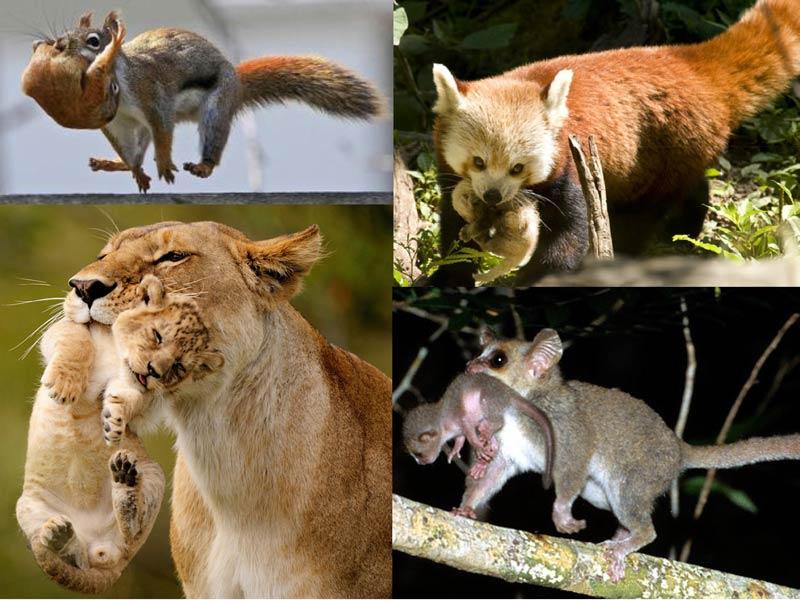Cat owners should know that if the cat is disobedient and pinches the back of its neck, the cat will be honest. Such a mythical beast can be controlled with one hand, so what about the big cat (tiger)?
This kind of behavior is widespread, of course, it has to be the little tiger first, and some othersinfantperiodanimal。 Not limited to cats, the mother of rodents, such as mice and squirrels, will also control their cubs by biting the back of the neck.

Adult animals rarely have this kind of reflex behavior, so to subdue them, never by sliding shovels or pinching the back of the neck. Secondly, biomechanically it no longer works. Because its weight and size have far exceeded itskinThe range that thickness and toughness can withstand.
Let’s talk about it firstWhyPinch the back of the cub’s neck, will it have a calming effect?
Dennis Normile published an article in Science in 2013 titleHow Rocking a Baby Is Like Mouth-Carrying a Mouse Pup. As mentioned in the title of the article, taking care of animal babies with the back of the neck with their mouths is similar to shaking the baby in their arms when a human baby cries – the physiological effects produced by these two methods are the same, and both stem from the protective instinct of motherhood.
The article introducesJapantargetnerveScholar Kumi Kuroda has noticed that when he picks up a crying child and walks around, the child tends to calm down quickly. After returning to the laboratory, he observed and recorded the crying and noisy behavior of 12 babies (1~6 months), divided into three situations: staying in the crib; the mother sits with the baby in her arms; and the mother walking around holding the baby. It was found that the mother walked around with the baby with the least chance of crying and making noise. And surprisingly, when the mother walks around with the baby, the baby’s pulse decreases and the crying lasts for two or three seconds instead of minutes.
Back to the topic: Why are cats (and other creatures) “fixed” under force on the back of the neck?
The animal grabs the skin of the back of the cub’s neck through its mouth, and when it is carried again, it will be passive, and adopt a compact posture, with its hind legs bent inward of the body. Kuroda’s group designed an experiment in which the mother mouse had to be removed from the cub placed in a cup (which would have to hold the back of the neck) and then track the heart rate and performance. The results were obvious, the cub was held in the back of the neck with a reduced heart rate, showed passivity, and was physically tense.

In subsequent experiments, they anesthetized the nerves on the back of the neck of the young mice, and the results showed that the “sedative effect” produced by “being picked up” was weakened. At the same time, part of it is surgically removedcerebrumInterfering with afferent signals from the cerebellar cortex also caused the mother mouse to spend more time calming the cubs.
If you can’t sense that the back of your neck is being held, the cub won’t curl up; If the cerebellum cannot receive the signal, the cub will not be calm and obedient. In other words, the weakening of the heartbeat and the change in body posture (the so-called fixation) are directly achieved by the parasympathetic nerve and the efferent nerve of the cerebellum. This series of physiological responses causes the young mice to have a lower heart rate, calm down, and curl up, making it easier for the mother mouse to take them to safety.
conclusion
After the cub’s back of the neck is held (pinched), the sensory nerves feel a signal of “Oh, the back of my neck is grabbed”, and then this signal is transmitted to the brain, and the brain processes and learns “I want to be quiet”, and the body part is “fixed” according to the instruction.

The Japanese experimental team further experimented to determine which part of the brain “gave instructions” to produce such a physiological effect. According to a 2018 study, researchers isolated the cubs from the mother mouse after birth and found that the sedative effect of holding the back of the neck was also weakened, and multiple brain regions, including the periventricular nucleus of the hypothalamus, were activated after isolation. This suggests that maternal absence can cause a stress response, leading to a series of changes in the brain.
After further research, the experimental team found that this series of responses is mediated by the involvement of adrenocorticotropin-releasing factor receptor 1 (CRHR1), which is released by the anterior cingulate cortex.
So, grasp the little tiger and become a “tiger mother” first.
